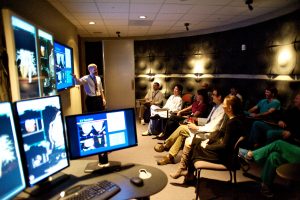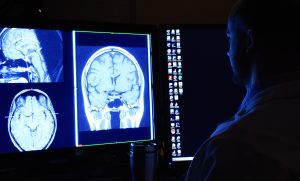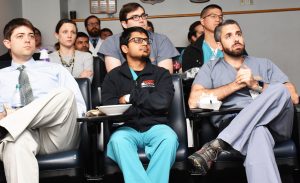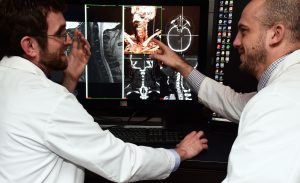A day in the life of UVA resident Connor Louden, MD
New and prospective residents are often curious about what their daily life will be like at UVA. Here’s a typical day described by Connor Louden, one of our former diagnostic radiology residents.
You can learn more about what a day in the life is like for current UVA Radiology residents, including in this time of COVID-19. Read about Xavier Mohommed (with a focus on changes brought by the COVID-19 pandemic), Nicole Kapral, or from two of our current interventional radiology residents.
7:15 am – 8:00 am: Case Conference
It’s early, but we dive right in anyways. Dr. Hanley, the attending physician for the day, addresses the class of residents. He shows us a CT scan that reveals cystic changes in the lungs. It’s different than what we’ve seen before in a case. Everyone is a little nervous because we know Dr. Hanley is about to call on one of us to diagnose the case. He calls on me. I state the type of study the case is depicting, the most salient finding, the secondary findings, and a differential diagnosis.
I give what I believe is the most likely diagnosis. Dr. Hanley points out and discusses what I did correctly and incorrectly in arriving at my diagnosis. It’s nerve-wracking to be the one on the case, but it’s good to get me thinking on my feet and verbalizing my thought processes. These skills are vital because they help me communicate well with other providers in the hospital. From now on, when I see a case like this, I’ll keep Dr. Hanley’s diagnosis in my mind.
8:00 am – Noon: Clinical Service
I am assigned to my favorite Radiology Division: Neuroradiology. I go to the Neuroradiology reading room and begin to read X-rays, CTs, and MRIs of the brain, neck, and spine.
One case I look at is of a patient with metastatic cancer. This patient presented with stroke-like symptoms, and I see an infarct on the MRI. Dr. Matsumoto and Dr. Muttikkal look at the case with me and we determine a clot in a vein caused the infarct. Afterwards, I consult with another group of doctors taking care of the patient and tell them what we found. Now they are able to make informed decisions about the patient’s care.
Other residents report to different divisions. For example, my friend Josh Smith goes to Breast Imaging today. He interprets and dictates mammograms, ultrasounds, and MRIs of the breasts for screening and diagnostic purposes. Having different residents work in different departments divides the responsibilities and optimizes patient care.
All residents are responsible for performing several other clinical duties throughout the day. We perform procedures, protocol studies, answer patients’ questions, communicate with other hospital personnel, and teach medical students. All before lunch.
Noon – 1:15 pm: Noon Conference
The noon conference is one of my favorite parts of the day. I get to see my fellow residents, and it’s nice to share part of the work day together. Plus, we eat lunch while we learn.
I’m eating a giant bowl of pasta with a glass of milk while looking at various bone tumors. Dr. Gaskin, one of our Musculoskeletal attending radiologists, presents a lecture on primary bone malignancies and how they might appear on X-ray, CT, and MRI. He gives us different tips on how to come to the correct diagnosis for each tumor. The entire lecture is interactive and engaging.
These daily lectures cover a wide variety of topics that help us improve on our daily clinical skills while also helping us prepare for future board exams. These daily pointers make us better radiologists so that when we’re looking at cases by ourselves we’re able to make the correct diagnosis.
1:15 – 5:00 pm: Clinical Service
It’s back to the Neuroradiology Division for me. My duties are the same, but it’s much busier this afternoon than in the morning. At this point, patients have had time to present to the Emergency Department. Other patients transfer in from other hospitals. We work hard to accurately and efficiently interpret all the ordered studies.
5:00 pm – 8:00 pm: Swing Shift
Tonight, my friend Nabeel and I do a swing shift together. This happens about once a week for every resident. During this time, two residents are “on call.” On call means that we interpret and dictate all imaging studies ordered during our shift.
We dictate studies ordered for the in-hospital patients and patients in the Emergency Department. It’s usually busy during this time.
Being on call is one of the more challenging parts of our training. We take pride in giving optimal care to our patients during this often stressful time. There are two paramount ways we care for our patients: First, we focus on our work and work quickly. Second, we make sure we constantly communicate with other hospital personnel. Working beside my fellow residents during this time pushes me to perform my best.
I’m the 1590 resident and Nabeel is the 1404 resident. This corresponds with the numbers on the pagers we carry. Each of us handles reading different types of images. As the 1590 resident, I read all the CTAs, CT chest, abdomen and pelvis scans, and ultrasounds. Nabeel reads radiographs (X-rays) and CTs of the brain and spine. We’re both in the same room, so we help each other. And of course, if we’re stuck, one of the Attending Radiologists is always available. Swing shift allows us a bit of autonomy, but assistance is readily available if we need it.
8:00 pm
The swing shift has ended. The two residents on night float, Tim and Brian, come in to take over. Nabeel and I pass on any important information about anticipated nighttime studies. After that, the workday has officially ended. For me, it’s off to the gym to get some exercise. Afterwards, I eat dinner and do some supplementary reading on interesting cases I saw throughout the day.
Lastly, I drift off to sleep feeling lucky. Lucky to work alongside a fantastic team of fellow residents. Lucky to collaborate with knowledgeable attendings and personnel. Lucky to care for the patients at UVA.





Neat!
Great job y’all! Sounds like a great program!
Say hi to dr Hanley for me!
Greetings from MUSC in Charleston, SC
Pál Suranyi
Hi Pál,
Thanks for your kind words about our Radiology Residency program here at UVA… we really appreciate it! And we’ll be sure to pass along your greetings to Dr. Hanley.
All the Best,
Alan Farr
Radiology Website Manager
Great Job ?when you love what you do every day is ??
I want to be part of your team.?
Many thanks Veronica! For more information about our residency programs: https://med.virginia.edu/radiology/services/residency-program/.
If you have any questions, please let us know.
All the Best,
Alan Farr
Radiology Website Manager
This is very educational! My name is Nabih Diab, MS3 @ Texas Tech El Paso. Very interested in IR and will be applying this Fall. I found this link retweeted by Dr. Sabri and if you don’t mind I will share this article with our members in the DR/IR student interest group on campus.
Thanks!
Hi Nabih,
We’re glad you found this article informative and to hear that you are interested in applying for our Integrated Interventional Residency program here at UVA. And yes, that would be great if you would like to share this article with members of your DR/IR student interest groups. You may also want to include a link to more info on our site about this program: https://med.virginia.edu/radiology/services/residency-program/interventional-radiology-residency/.
Please let us know if you need anything further.
Alan Farr
Radiology Website Manager
I have just had a slew of imaging and am in recovery. ( long and slow but I’ll be ok). The bills are coming and while, in theory , I know what radiologists do , I wanted to know more. It’s
interesting knowing all these backstage people are involved. Reading this is fascinating.
Maryann,
We wish you a speedy recovery. I’m glad that you found our article interesting; we love what we do, and enjoy sharing our knowledge with everyone.
Basia Nowakowski
Medical Education Programs Director
This is fantastic.This kind of program will keep you on your toes.Weldone!
Brilliant read. Very rare nowadays as most people just write a quick article just to get more views. This one is different! Both informative and helpful. Thank you!
Thanks so much, Arlie. We’re glad that you enjoyed this in-depth look at a typical day of one of our Radiology residents.
Brian Simalchik
Multi-Media Specialist, Radiology Marketing
Hi, I am wondering what procedures diagnostic radiology residents usually perform. I am asking this cuz I don’t really fancy procedures lol I know you guys do some biopsies and all but would like know more in details. Diagnostic vs. interventional esp.
Here’s a response from current resident Nicole Kapral:
As a diagnostic radiology resident we rotate through the various divisions and departments of radiology (much like one may do for internal medicine or pediatrics). These various specialties include mammography, thoracic and abdominal imaging, pediatric imaging, musculoskeletal imaging, neuroradiology, interventional radiology, and several others not listed. We are required to have various amounts of time in each specialty to ensure we are well-rounded and to help pick a fellowship. Your schedule is set by the department to ensure you reach these requirements, so you don’t have too much choice regarding what rotations you will do until 4th year when you can choose some elective months and “mini-fellowships” which are 3-6 month periods of dedicated time in one area. This is likely the case at most residency programs as the time requirements are set by ACGME and standard across radiology.
Regarding procedures – what you do depends what rotation you are on, for example:
– Mammography: first years see patients and perform ultrasounds; second years begin doing breast biopsies
– Abdominal: this is a procedure heavy service where you will perform ultrasound guided paracentesis, thoracentesis, renal biopsy, liver biopsy, thyroid biopsy, drain placement etc (typically a month long rotation like everything else).
– IR: obviously the most procedure oriented rotation. It’s not for everyone, but people typically end up liking it more than expected, even if it’s ultimately not for them (also only a month at a time).
That’s it for the most part. We do not do procedures on thoracic, MSK, neuro etc. We ultimately do a couple months of procedures each year. For what it’s worth, plenty of us are not procedure oriented, but have come to enjoy them since it’s a short period and helps change up the work flow.
IR residents have a similar schedule with additional months of IR, though it doesn’t sound like this applies to you so I will not go into too many details.
Are resident’s in teaching hospitals doing the only reading of a brain MRI, or any MRI? I only ask as a resident read a brain MRI outlining all the structures and the impression was normal MRI. The resident neurologist showed it to me and said it’s not normal, she would go back to the radiologist. There was an addendum. There is edema and heterogeneous enhancement throughout the right medial temporal lobe . Findings concerning for acute encephalitis or low grade glioma. This was afternoon, not the ER, admitted with confusion, and reporting some kind of episode’s that were happening every 5-7 minutes until the confusion started. I guess I thought there would be an attending neuroradiologist that confirms brain MRI readings. The neurology resident explained it as we are all human and things can get missed. I was just really glad she looked closely at the MRI. I asked if it was read by a resident? Yes, it was. The addendum was written by a practicing radiologist part of a group at another teaching hospital in the state two hours away. I guess I thought an attending signed off on everything. We still don’t have a diagnosis, working with a neurosurgeon and a seizure specialist, awaiting a brain biopsy. It’s a very busy level 1 Trauma Center. Does the hospital push you to get these reports out so quickly you are rushed, you just totally don’t see something? I know with the level of the illness someone would have caught the mistake, I was just really surprised. I think if an attending signed off on this as a normal MRI I would be bothered. I personally had a brain MRI and my neurologist read it and had two other neuroradiologist do a reading. I realize there is a difference in a teaching hospital and a private physician. I’m not upset, I just wonder how often things get missed?